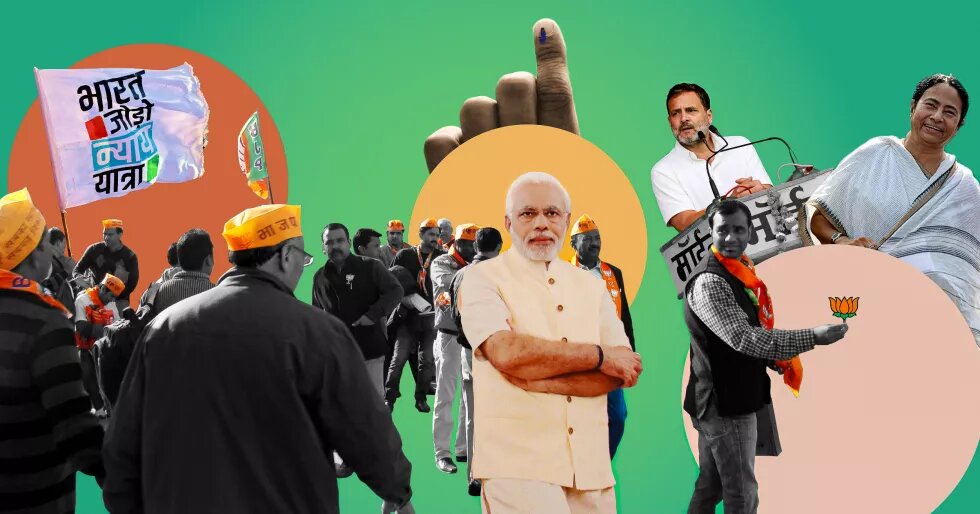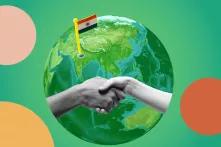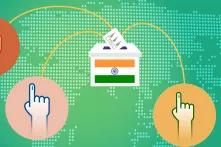As India, the world’s largest democracy, heads towards its 2024 general elections, the ruling Bharatiya Janata Party (BJP) under the leadership of Narendra Modi seeks another five year term amidst collective mobilisation by opposition forces.

“Indian democracy and competitive elections continue to generate global interest and wonder partly because of their uninterrupted success despite the obvious challenges of demography and geography.”
-S. Y. Quraishi An Undocumented Wonder : The Making Of The Great Indian Election, New Delhi : Rupa
The Republic of India, being constituted as a representative democracy, rests fundamentally on a system of periodic elections to its bi-cameral legislature. Out of the two houses of India’s parliament, the elections to the lower house called the ‘Lok Sabha’ (House of the People) is conducted every five years as per provisions of the Indian Constitution. The 18th edition of the Lok Sabha elections to be held in independent India will take place in multiple phases between 19 April and 01 June 2024. The first general election in 1952, a gigantic exercise in a newly independent country, established the Indian election as the biggest in the world. The trend has only expanded since then. Of the 4.2 billion people potentially participating in what has been termed as the election year globally, with at least 65 countries holding elections, almost one billon will be Indian.1
The 2024 general election in India will take place in a context of significant consolidation of political power and amidst speculations about systemic changes, owing to the emergence of a ‘one party dominant system’ in India, centred around the continuing rise of the Bhaiatiya Janata Party (BJP). A phenomena that some political analysts argue could cause an absolute decline of the opposition parties, possibly marking a transition to a situation of ‘elected authoritarianism’ or ‘competitive authoritarianism’, where the functioning of democratic institutions, such as the parliament, judiciary, election commission, free press, are undermined through the manipulation of state institutions and resources2. Other commentators, however, find such views to be exaggerated and call for a fresh and nuanced analytical framework to comprehend the dynamics of the democratic challenges under the BJP rule, placing it in the wider context of nationalist-populist leaders remaking their countries’ politics to conform to their ideological worldview.3 In any case, the fact remains that the BJP led by Prime Minister Narendra Modi, which came into power in 2014, continues to emerge stronger with each passing election in recent years and will seek to further establish its dominance by forming the government for the consecutive third time. In 2019, the BJP received 37.36% of the vote, the highest vote share by a political party since the 1989 general election, and won 303 out of 545 Lok Sabha seats.4
There has been concerted mobilisation by different parties that seek to challenge the electoral dominance of the BJP and its allies in the ‘National Democratic Alliance’ (NDA). Forty political parties led by the principal opposition party, the Indian National Congress (INC), have come together to form the ‘Indian National Developmental Inclusive Alliance’ (INDIA). The countdown to the polls therefore begins, through various mobilisations and counter-mobilisations, spirited campaigns and a clash of agendas and assurances from various political parties. It is pertinent at this point, to take stock of the key debates that inform the present electoral discourse in India and the key parameters that are likely to shape the behaviour of the Indian voters. It is a narrative containing multitudes within, encompassing contradictions that are interlocked in a manner that reflects the very essence of the Indian polity.
Enduring identity politics: the majoritarian dividend
The run up to the 2024 Lok Sabha elections has been marked by a number of significant events in the recent political history of India. This includes the inauguration of the newly constructed ‘Ram Temple’ in Ayodhya in January 2024. The temple has been built on a site where the centuries-old Babri Masjid mosque once stood. In 1992, the Babri Masjid mosque was demolished by a mob over claims that it had been built over the birthplace of the Hindu deity Rama. A chain of events that has contributed to serious communal tensions between Hindus and Muslims in India. The passing of the 2021 Citizenship (Amendment) Act (CAA), aiming to award citizenship to individuals from six persecuted religious groups, excluding Muslims, from the neighbouring countries of Pakistan, Bangladesh and Afghanistan, and the abrogation of the special status of the state of Jammu and Kashmir by repealing Article 370 of the Indian Constitution, the provisions of which imparted this Muslim-majority region, and a region of high geo-political tensions, a degree of political autonomy from New Delhi, have also stoked concerns.
These events play out electorally by continuing to infuse into the political system an identity-based politics built around the notion of India as a majoritarian Hindu nation, an ideology referred to as ‘Hindutva’. Built around historical narratives and its reference in present times, this political discourse continues to cause ideological polarisation, even as the ideological camps keep changing their form and size. In this context, the BJP sought electoral validation for the construction of the Ram Temple in Ayodhya, while simultaneously condemning the INC as “anti-Hindu” for rejecting the invitation to the inauguration ceremony. The implementation of CAA just before the elections also adds to the narrative of “correcting past injustices” that the BJP has been pushing for in recent times; the party has adopted a strategy of systematic critique of the role played by INC leaders during the partition of India, which the BJP claims was to appease Muslims to the detriment of Hindus and other religious minorities being persecuted in neighbouring countries. Interventions proposed as ‘corrective measures’, therefore, ought to help further solidify BJP’s ‘Hindutva’ appeal. One also needs to appreciate the significance of such a move in some of the electorally significant states in India, most prominently in West Bengal, which ranks third in terms of the number of members it sends to the Lok Sabha, following Uttar Pradesh and Maharashtra. The CAA’s impact will especially be felt in 15-18 constituencies across the state where communities like the Matua and the Rajbanshis are dominant, many of whom are Hindu refugees from Bangladesh and thus stand to gain from the newly amended citizenship laws. The opposition parties, meanwhile, seek to use the enactment of CAA as a counter-mobilisation plank by highlighting the discontent among religious groups and regional governments. In some places Muslim groups (referred to as ‘minorities’ in the Indian context) have rallied against the Act on the ground that it perpetuates religious bias. Sentiments in the northeastern and southern parts of the country have been mobilised too—the Act has been projected in some quarters as an instance of a dominant centre coercing its will on the regional units. As Amit Prakash, a political commentator notes, there often is an interplay of local and national narratives in the national elections in India5. He goes on to say, “since all national elections have been contested locally in geographically defined constituencies ever since independence, regional and local issues have made their importance felt in every election.” National parties have therefore often tapped into regional issues and co-opted the regional agenda—an example of the osmosis between the ‘national’ and the ‘regional’. The BJP has thus successfully diffused the anti-CAA protests in northeast India and the other regions, as far as its electoral impact is concerned, by appealing to regionalist agendas around development and identities. Going by recent trends, the BJP’s extensive outreach programmes and activities seem to have overshadowed the counter strategies by the opposition. To understand this phenomenon, one needs to pay attention to a particular ‘re-packaging’ of the traditional voter groups that used to be mobilised around caste, religion and ethnicity.
Crafting electoral clienteles: competing moves
The BJP led NDA is hoping to continue with the successful experimentation of stitching together a winning electorate consisting of sub-groups of voters having divergent socio-economic realities. In a speech last year, Prime Minister Modi identified the poor, youth, women and farmers as the four “biggest castes”6, a statement that was re-iterated by the finance minister this year in her budget speech7, where she called the four categories as the fours major castes of a new India, as she went on to highlight the various government schemes aimed at the welfare of the four. Given the fact that studies show that in recent times a significant section among the Scheduled Castes (SCs), Scheduled Tribes (STs) and Other Backward Classes (OBCs) across India have shown support to BJP in different elections, commentators are calling this phenomena a ‘Subaltern Hindutva’8. Therefore, even as BJP recognises the political salience of these identity groups, they seek to subsume them under a developmental agenda predicated upon the “Modi Ki Guarantee” (“Guarantees by Modi”) scheme, a cornerstone of BJP’s electoral strategy with a special focus on individuals belonging to these four groups. It will be significant to observe to what extent the INC’s own campaign around “Nyay (justice) guarantees” can be an effective response to this as it talks about different measures of upliftment for the similar segments of society. Electoral success in recent state elections in Himachal Pradesh, Karnataka, and Telangana, scripted around such an agenda, has given the INC some hope and confidence. Through targeted interventions and measures such as subsidised cooking gas, free food ration kits, free electricity and free mobile phones, and various health, income and housing-related schemes—the Pradhan Mantri Kisan Yojana (income support scheme for farmers), Pradhan Mantri Ujjwala Yojana (scheme to provide clean cooking fuel to rural and low-income households), Pradhan Mantri Jan Dhan Yojana (a national mission for financial inclusion) and ‘Pradhan Mantri Awas Yojana’ (scheme to make affordable housing accessible)—the BJP claims to have created a new class of beneficiaries—the ‘labharthis’. The party claims that it has thus built a loyal labharthi vote base of 250 million nationally9. Besides, this shift from the traditional rights based approach, where welfarism was done though participatory legislation to that of a situation of technology enabled direct benefit transfers, allows leaders to directly reach voters, thereby giving rise to the observation that, “it is the BJP in the image of Prime Minister Narendra Modi that has perfected techno-patrimonialism to an art from and reaped significant electoral benefits for it.”10
The aspirational roadmap that performs
This ground dynamic has to be read side-by-side with the fact that about 18 million first-time voters will participate in the 2024 elections, and that just under 200 million voters are between the age of 20 and 29 years.11 Here it is important to note that for all the first time voters and for most of the young voters, the BJP is the only political party they have seen in power and Narendra Modi is the only Prime Minister they have known in their active political memory. This familiarity might turn into the BJP’s advantage. However, to understand the strong support of the young voters to the BJP, one has to look into the different strategies that the party seems to have adopted to successfully build inroads into the youth. Studies have shown that twice as many youths voted for the BJP as compared to the INC in the previous Lok Sabha elections - despite unemployment recording new highs that year.12 The BJP has been consciously targeting this age group via protracted social media campaigns. Prime Minister Modi himself has been making regular direct contacts with the youth through radio programs, cast through his dedicated social media channels. Information on many ongoing government schemes as well as future visions reaches the youth regularly on their smartphones, many a times from the social media handles of the Prime Minister himself, thereby giving the impression of a direct communication channel between the youth and the head of the government.
Whereas one section of the youth seem to be affected by the majoritarian rhetoric of ‘Hindutva’, others gravitate to the BJP for what they see as a successful projection of India as a global super power, and again another lot is influenced by its many promises on the developmental front. It is this mixed discourse that the party has carefully produced that appeals to, one, a sense of historical grievance shared by some (‘Hindus in danger’ due to minority appeasement by previous governments etc.), two, a sense of pride (Modi as a respected world leader, his ‘strong man image’ and image of India as emerging world leader) and three, a sense of aspiration (visibility of many new infrastructure projects and perceptions of change on ground).
Against the prevailing situation of joblessness and outmigration of the youth from the country, the government is seen to be initiating programmes for skill development, incubation centres for start-ups, promoting local entrepreneurship and so on, thereby persistently trying to create benchmarks around aspiration. This curtails the scope for the opposition parties to electorally capitalise on the sense of insecurity and frustration arising out of unemployment. Narratives like 'Viksit Bharat’ (Developed India) Mission, ‘Amrit Kaal’ (Age of Prosperity), which are constantly communicated to the youth, remain dominant themes, underscoring aspirations for national progress. However, the data shows that social media contents primarily aimed at the youth which are expressly critical of the government actions are also gaining steady traction over time. A trend that shows that a significant section of the Indian youth is perhaps aware of the complexity of social debates.
The discontents and its limits
Through its many schemes and agendas, the BJP seems to have crafted a comprehensive social engineering programme that binds individuals from a wide spectrum of backgrounds together, including adherents of different ideologies and people belonging to different demographic and geographic groups. However, recent events in the country such as the ongoing violence in the northeastern state of Manipur, the farmer’s protest, rising unemployment, inflation and the Supreme Court verdict scrapping the ‘Electoral Bond Scheme’ have provided some ground for mobilisation to the opposition. The question remains: can the opposition build an effective counter-narrative that critiques and weakens the sustained crafting of the composite electoral clientele by the BJP through its extensive mechanisms and programmes? The answer will be decided by the electoral verdict of the world’s largest democracy soon.
Disclaimer:
This article was prepared with the support of the Heinrich Böll Stiftung. The views and analysis contained in the publication are those of the author and do not necessarily represent the views of the foundation. Heinrich Böll Stiftung will be excluded from any liability claims against copyright breaches, graphics, photographs/images, sound document and texts used in this publication. The author is solely responsible for the correctness, completeness and for the quality of information provided.
Footnotes
- 1
“Just how big is India’s 2024 election? Find out in seven numbers”, https://www.aljazeera.com/news/2024/3/16/india-announces-election-2024-seven-numbers-to-unpack-worlds-biggest-vote
- 2
James Manor. 2021. ‘A New, Fundamentally Different Political Order: The Emergence and Future Prospects of ‘Competitive Authoritarianism’ in India’ ( https://www.epw.in/engage/article/new-fundamentally-different-political-order)
- 3
Rahul Verma. 2023. ‘The Exaggerated Death of Indian Democracy’, https://journalofdemocracy.org/articles/the-exaggerated-death-of-indian….
- 4
“Analysis: Highest-ever national vote share for the BJP”, https://www.thehindu.com/elections/lok-sabha-2019/analysis-highest-ever-national-vote-share-for-the-bjp/article27218550.ece
- 5
Prakash, Amit. (2008). “Group Discrimination and Elections in India,” in Dushyantha Mendis (Ed.), Electoral Processes and Governance in South Asia (pp. 341–406). New Delhi: Sage.
- 6
Sharma, Harikishan. (2023). “4 biggest castes for me are poor, youth, women and farmers: PM Modi,” The Indian Express. https://indianexpress.com/article/india/pm-4-biggest-castes-for-me-are-…
- 7
The four new castes of India, according to the Finance Minister,”CNBC TV18.https://www.cnbctv18.com/economy/budget-2024-sitharaman-says-poor-women…
- 8
Wankhede, Harish S. (2023). “BJP’s subaltern Hindutva strategy and the crucial social justice test’,” The Hindu. https://www.thehindu.com/opinion/op-ed/subaltern-hindutva-and-the-cruci…
- 9
Tiwari, Amitabh. (2022). “BJP banks on Labharthi factor in UP but past losses show it has its limits,” India Today. https://www.indiatoday.in/elections/uttar-pradesh-assembly-polls-2022/s…
- 10
Aiyar, Yamini. (2023). “Citizen vs Labharthi? Interrogating the Contours of India’s Emergent Welfare State,” The India Forum. https://www.theindiaforum.in/public-policy/citizen-vs-labharthi
- 11
“Lok Sabha elections 2024: 97 crore registered to vote, 2 crore young electors added, says EC,”Business Today. https://www.businesstoday.in/india/story/lok-sabha-elections-2024-97-cr…
- 12
Reddy, Anisha. (2024). “Youth Unemployment: The Young And The Restless Want More Jobs This Election,” Outlook India. https://www.outlookindia.com/national/youth-unemployment-the-young-and-…


